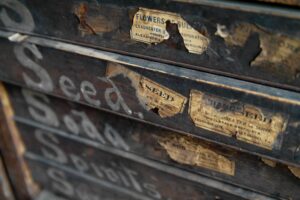Seed saving has been a fun and productive pastime since the day dot & the reason why we have food from crops today.
Some of the many benefits to saving your own heirloom seeds include climatised crops, zero cost (on seeds purchasing), zero chemicals, creating stronger communities by swapping viable, fresh seeds & always having quality seeds on hand. Most of all, it gives us first hand reassurance of how our seeds have been cared for. It’s easier than you think, and with a little knowledge, you too could be on your way to helping the global cause of food security and keeping our important heirloom varieties alive.
Let’s look at some of the reasons and benefits about starting your journey with seed saving.
Support and Knowledge
The tradition of seed saving is having a resurgence amongst many gardeners and thankfully there are now plenty of local groups who will only be too happy to support you in your journey. They can be easily found on social media platforms like Facebook and Instagram or even by contacting your local Neighbourhood House or City Council. A visit to your local library or even a quick google will also give you all the information you need.
Learning the art of seed saving will also help make you a better gardener! You’ll notice your local growing conditions more and what’s happening to your plants! Which ones produce to your liking and how to have influence in the process. There is so much to learn, by succeeding in seed saving.
Produce Healthy Strong Crops
When seed saving, we tend to keep seeds from our most productive, pest-free and tastiest plants. Depending on your climate and wants, you might save your seed from the plants that develop quicker, have a better heat or cold tolerance, produce more or show a higher resistance to pests and disease. Whatever traits you are looking for you will be able to plant the seeds you save each year to produce plants that work best for your climate and conditions, ultimately producing healthy, strong and nutritious crops.
Sharing is Caring
One of the biggest (but best) problems with seed saving is you’ll end up with more than you can use! But don’t despair, they make great little gifts, wrapped up in handmade envelopes or swap them with neighbours, friends or those on seed-saving networks. Maybe even start a local seed-saving network yourself. Remember that depending on the variety of vegetable, some seeds, if kept well can last more than 4 or 5 years – so you’ll have plenty to last!
[/vc_column_text][/vc_column][/vc_row][vc_row gap=”20″][vc_column][vc_column_text]
Seed Saving is Easier Than You Think
Like everything, some seeds are much easier to save than others, so you might want to start with those varieties first to build confidence and develop the basic skills. Once you’ve succeeded, you’ll understand how easy it is to pollinate and quarantine those tricky varieties like a pro!
The Basics
It’s true that some seeds turn our better than others, but we know that healthy, well watered plants will usually have more energy to form healthy and abundant seeds, so its important to make sure the plant has all the love they can get! We want to save seeds from plants free of disease to stop pathogens being stored in the seed and being passed onto the future seedling.
For some crops, seed saving is as simple as collecting ripe seed from an existing heirloom crop, cleaning and drying the seed and packaging for the next season. For other crops, the process is a little more involved. For example, pumpkins and zucchinis will readily cross pollinate with other varieties and can produce seeds that will produce inedible produce or plants that are not true to type. To maintain the integrity of these crops isolation or pollination by hand where the flower is kept quarantined away from bees and insects with little bags and manually pollinated is required. This will produce seeds from the fruit that are true to type (same as its parents).
Members of the Brassica family such as cauliflower, cabbage, broccoli and kale are all notorious for cross pollinating and producing some rather unusual offspring.
What Varieties Should I Start Saving?
Over the years, we have found the following varieties easier to save. With lost of different varieties to suit your taste, there is a lot to choose from:
A lot less finicky than most, they will produce an abundant amount of seeds that will last years, be easy to collect, to clean and to store! Just remember to label them through the process to make sure you don’t loose track of what they are!
*Will readily cross pollinate but by growing only one variety or separating multiple varieties as much as possible your plants will generally produce true to type seed.[
Storing Your Seeds
A great way to store your clean and dry seeds is in seed or coin paper envelopes which can be found at your local office supply store. (Why not try making your own with these instructions Gardens Illustrated -How to make a seed envelope)
Make sure you label the envelope with the variety name and the month and year of your seed harvest. If you’ve done any germination testing, the date of the test and rate will be useful when keeping the seeds for longer periods.
Keep your seeds in a cool, dry, dark place out of reach of direct sunlight. You can also keep your seeds in the refrigerator, but make sure they are inside an airtight container with a packet or two of silica gel for extra insurance. Remember, when you take the jar out of the refrigerator, open the lid to stop any condensation forming inside the jar.
Why not start with one variety and build up your knowledge from there!




